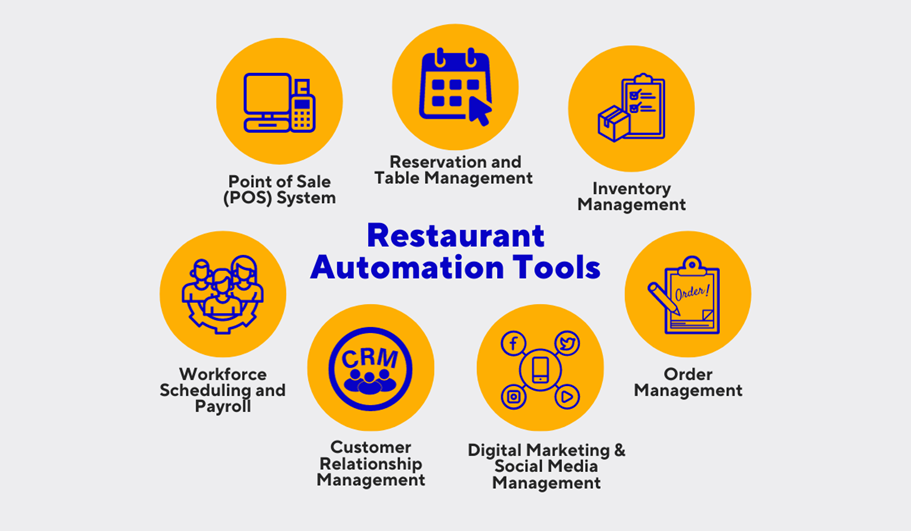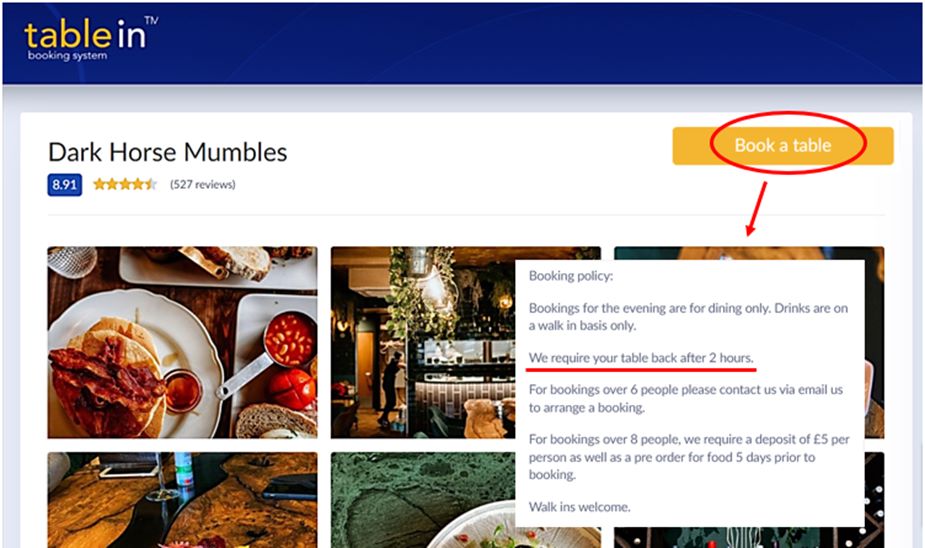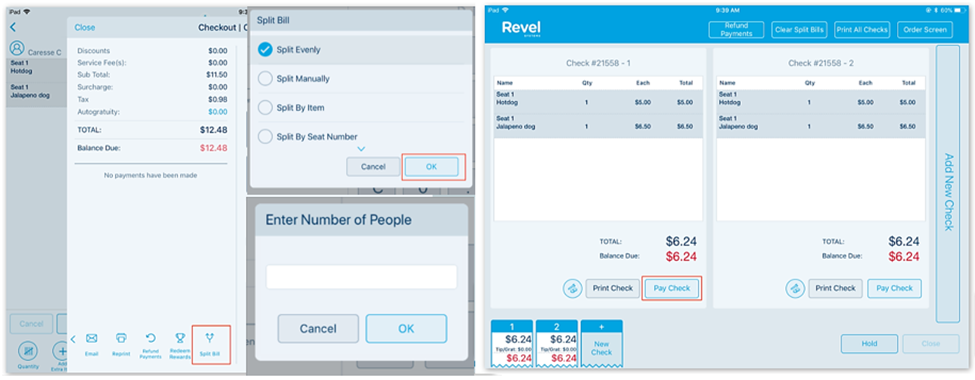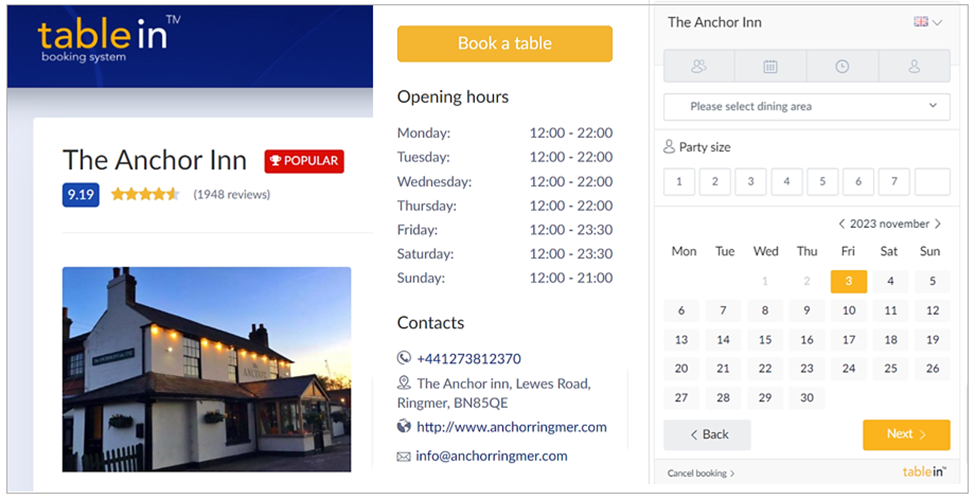In today’s digitized world, restaurant operations still revolve around handling customer orders and reservations, managing kitchen staff and servers, tracking inventory levels, and engaging in marketing activities.
However, all these and other restaurant processes now typically also involve some kind of automation technology.
We’re not talking about fully automated kitchens or robot waiters, but rather various types of software that restaurants use to automate specific tasks, such as billing and payment, table bookings, staff scheduling and payroll, inventory management, or digital marketing.
In this context, we’ll explore what restaurant automation is, why it’s beneficial for restaurants, and what tasks they can automate to make their operations more efficient and profitable.
What Is Restaurant Automation?
In the broadest sense, restaurant automation encompasses the use of any technology to streamline and optimize various day-to-day management tasks within a restaurant.
As such, this term may include innovative technologies like self-ordering kiosks, automated cooking systems, or food delivery drones.
However, this guide's primary focus is on software solutions that do not rely on separate automated machines or robotics.
Instead, these solutions are designed to operate on devices commonly found in restaurants, as well as those used by their customers, such as desktop computers, laptops, smartphones, and tablets.
This subcategory of restaurant automation tools is still a very broad one, as it includes software solutions like the ones shown below.

Source: Tablein
For instance, almost all restaurants nowadays use an electronic point-of-sale (POS) system that automates the process of calculating bills and handling payments.
Such a system is also often integrated with other tools, like order management or kitchen display systems.
Naturally, some software providers want to automate all restaurant operations within one system, so they offer even more comprehensive, all-in-one restaurant management systems.
In any case, all these and other software solutions enable restaurants to streamline their restaurant management activities and realize a range of benefits.
On that note, let’s see how restaurants can leverage automation tools to their advantage.
Why Is Automation Beneficial to Your Restaurant?
Considering that efficiency and cost-effectiveness are paramount for any restaurant’s success, various automation software solutions have emerged as the best tools to address these challenges.
Automating various aspects of restaurant management generates a myriad of benefits that can significantly impact your staff's performance and your restaurant’s profitability.
In this section, we'll delve into three key aspects of how automation enables you to improve restaurant operations.
Automates Time-Consuming Tasks
For restaurants not using automation software, several tasks can be particularly time-consuming, such as order processing, inventory tracking, and reservation management.
For instance, consider the time required to take customer orders manually, transmit them to the kitchen, and then input them into a billing system.
These processes are not only time-consuming for your staff, but also expose your establishment to the risk of placing wrong orders, slower service, and potentially dissatisfied customers.

Source: Food Safety News
Likewise, keeping track of inventory levels and ordering supplies manually is cumbersome and can result in overstocking or understocking issues, which can lead to increased food waste or gaps in your menu offerings.
In the same vein, manually handling reservations, including phone calls, recording details, and allocating tables, is a labor-intensive process that can lead to double bookings and other errors.
Conversely, using an automation tool such as table booking software means that your employees won’t have to spend time taking reservations over the phone or manually sending reminders to guests.
Similarly, when automation software is applied to order processing, inventory tracking, and other restaurant operations, your employees will have more time to focus on delivering exceptional service to customers.
Therefore, by automating time-consuming tasks, different software solutions allow you to enhance your customers’ dining experience and improve the overall efficiency of your establishment.
Helps Reduce Costs
Cost control is a constant concern in the restaurant industry, and automation can play a pivotal role in minimizing your expenses and maximizing profits.
For example, automated staff scheduling and payroll systems allow you to match staff schedules to peak business hours, thus reducing unnecessary labor expenses.
Beyond scheduling, automation can provide real-time labor cost monitoring, helping you identify and address inefficiencies and control labor expenses more effectively.
Likewise, by automating inventory tracking and ordering, you can optimize stock levels, minimize food spoilage, and reduce food costs.

Source: Restora POS
Since most inventory management software also provides data analytics, you can analyze customer preferences and sales data to focus your menu on high-margin items, thereby further reducing food costs and waste.
Similarly, various automated systems like digital food safety checklists and real-time sanitation trackers can assist you in ensuring compliance with health and safety regulations, thus reducing the risk of fines and penalties.
Lastly, automation also extends to managing energy usage in your restaurant.
Such software systems can control lighting, heating, ventilation, and air conditioning (HVAC) based on occupancy and time of day, reducing energy consumption and lowering utility bills.
Overall, there is almost no restaurant operation that can’t be monitored and optimized by using some type of automation software, allowing you to reduce your restaurant’s labor, inventory, and utility expenses.
Increases Table Turnover
Your restaurant’s table turnover rate is in many ways the most important measure of its efficiency and profitability.
This key metric tells you how many customers are served per table during a specific period.
To calculate it, you would select a measurement period (e.g., 4 hours during lunch or dinner), track the number of parties served in that period, and then divide this number by the number of tables those parties occupied.

Source: Tablein
This calculation provides valuable insights into your restaurant's operational performance and capacity utilization, particularly when it’s bustling with guests eager to get their table.
In such cases, increasing the table turnover rate translates into serving more people and, as a result, higher revenues and tips.
So, how can software solutions help you increase table turnover?
We already mentioned a few examples like using the POS system to facilitate fast payment or employee scheduling software to optimize peak-hour staffing, thereby ensuring turnover time is not prolonged by slow service.
However, one of the most efficient tools for maximizing table turnover is using an online table booking system like Tablein.

Source: Tablein
This software widget is easily integrated into your restaurant’s website, allowing you to accept online table reservations 24/7 without the need for manual intervention.
When potential guests visit your website to book a table, they’ll be able to choose the date and time of their visit, and Tablein will automatically check table availability and confirm the reservation.
Naturally, not having to call or email the restaurant to make a reservation is very convenient for your customers and your staff.
Moreover, such an online booking system allows you to improve the table turnover rate by specifying the reservation length in your table booking policy.
For instance, when you click on “Book a table” in this restaurant, their booking policy will pop up, informing you that they require the table back in two hours.

Source: Tablein
That way, the guests know the maximum allotted table booking time in advance, which can significantly improve reservation management and minimize the issue of lingering guests.
Additionally, Tablein will send customers automatic reservation reminders by e-mail or SMS, enable you to charge deposits for table bookings, and ask your guests for feedback.
In summary, various automation tools, including POS, staff scheduling, and online table booking software, can help you monitor and enhance your restaurant’s table turnover rate, allowing you to efficiently serve more guests during peak hours, thus boosting your revenues.
What Tasks Can You Automate?
It’s clear by now that software solutions can be used to automate almost any restaurant management task, such as menu planning and development, order taking, staff training and management, health and safety compliance, financial management, or digital marketing.
However, it’s worth exploring in more detail what specific restaurant operations such solutions can automate and how restaurant owners can use them to generate efficiency gains and cost savings.
This section will focus on three practical aspects of restaurant management: billing, table booking, and inventory management.
Billing
In restaurants that rely on manual calculations and paper receipts, the billing process typically involves several steps that may be time-consuming and have a higher potential for errors, especially during busy periods.
Conversely, today’s market offers many specialized and all-in-one restaurant management software solutions that automate various or all aspects of billing customers.
For instance, we mentioned how different point-of-sale (POS) systems can significantly expedite the billing process.
Basic POS systems enable restaurants to electronically charge customers using credit or debit cards after manual bill calculation, providing a fundamental level of convenience for both guests and staff.
More comprehensive POS systems offer a range of additional benefits like instant order customization and processing, bill splitting, and seamless integration with inventory management systems.

Source: Square
In essence, such restaurant management systems can streamline and enhance the entire customer-serving process, from order taking to billing.
For instance, customers can place their orders with the server or through a digital ordering system, such as a tablet or smartphone application.
The order is instantly transmitted to the kitchen and the POS system, eliminating the need for handwritten order tickets, and ensuring the bill is accurate.
The bill is generated digitally and printed, or customers can review it on a screen and receive it via email or a mobile app, making the entire transaction paperless and environmentally friendly.
Splitting the bill among a group of diners is no longer a time-consuming process but easily done in a few clicks, like in this example.

Source: Revel Systems
When paying, customers can settle their bills using an array of convenient payment options such as credit or debit cards, digital wallets, and contactless payments.
Not to forget about tips, some POS systems allow customers to enter a tip amount directly when making an electronic payment.
As we’ll see, when such systems are integrated with inventory management, this further enhances operational efficiency and streamlines the billing process.
We can conclude that modern restaurant management software solutions—including POS systems—empower restaurants to create a more efficient, accurate, and customer-friendly billing process that aligns with the expectations of today's diners and improves overall restaurant operations.
Table Booking
We already discussed how an online table booking system can help restaurants improve their table turnover rate and increase peak-hour revenues by communicating reservation time limits and allowing staff to focus on serving customers instead of handling phone calls and emails.
In other words, online table booking tools have ushered in a simpler and more convenient reservation process for both customers and restaurant staff.
With just a few clicks, guests can select their preferred date and time, view available tables, and receive an instant confirmation.
Since an online booking system is not bound by business hours, customers can reserve a table at any time.

Source: Tablein
Naturally, this 24/7 accessibility caters to the convenience of your diners.
Additionally, it minimizes the risk of manual errors, such as double bookings, and automates reminder notifications, reducing the likelihood of no-shows.
Similar to some billing systems we covered, online booking software can be used to store important info about your guest’s order preferences or requirements (e.g., allergies) along with other notes (birthday, discounts, etc.).
This not only enables you to improve the guest experience but also provides valuable insights through reservation data analytics.
In other words, you can use it to identify peak dining hours, understand customer booking trends and preferences, and make better-informed decisions for your restaurant’s success.
Overall, online table booking has become standard in the restaurant industry due to its non-stop accessibility, as well as the convenience and efficiency of table reservations for both your guests and your employees.
Inventory Management
As we've already mentioned, inventory management software, most often integrated with the POS system, is crucial for controlling costs and reducing waste.
Modern restaurant inventory management tools take the guesswork out of the process by enabling real-time tracking of stock levels and automatically generating alerts when items need replenishment.

Source: MarketMan
For example, if your restaurant is running low on a particular ingredient, the system will promptly notify your kitchen staff or a pantry manager, thus ensuring that you never run out of essential items during busy hours.
Additionally, inventory management software provides insights into usage trends and helps optimize stock ordering, helping you avoid overstocking and minimize waste.
To recap, whether integrated with the POS system or not, inventory management tools enable real-time stock tracking and automated low inventory alerts, making this aspect of restaurant operations more efficient and cost-effective.
Conclusion
It’s clear that restaurant automation technologies are revolutionizing the dining industry, enhancing efficiency, reducing costs, and optimizing operations.
From automated billing to online table booking and inventory management, software solutions have become essential tools for modern eateries.
By embracing these technologies, restaurants are empowered to provide excellent service and a great customer experience while controlling costs, increasing productivity, and maximizing profitability.
Get a 30-day Exclusive Trial
As a Tablein blog reader, you’re eligible for an exclusive 30-day free trial to experience our simple reservation solution for your restaurant.
Enter your business email, and we’ll send you all the steps needed to create your account.
Share this
You may also like

5 Ways Restaurant Automation Improves Efficiency

4 Ways to Increase Your Table Turnover With Restaurant Automation
